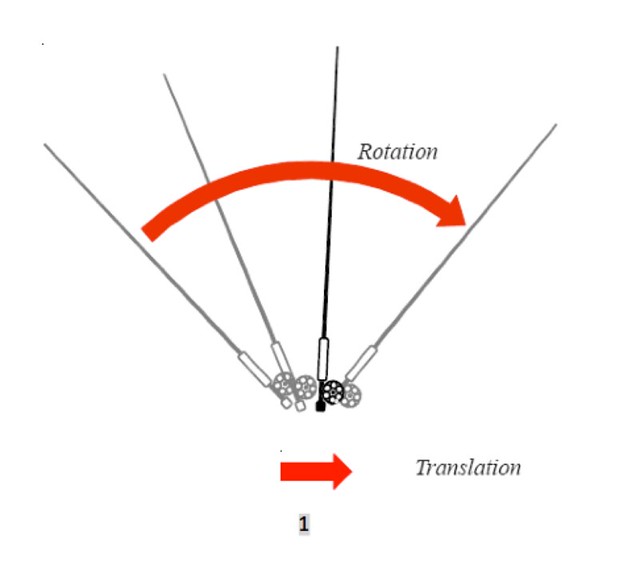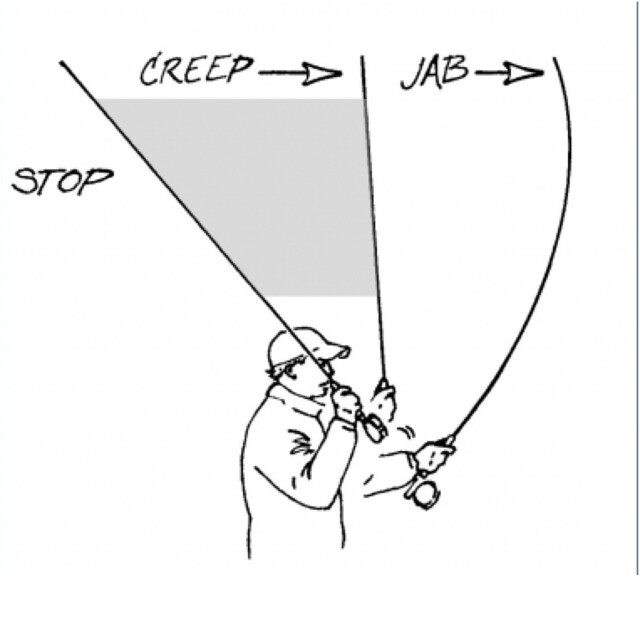silver creek
Well-known member
I was replying to a fly casting post another BB and part of the discussion was about rod creep and rod drift during the cast. It occurred to me that there has not been a comprehensive discussion of rod creep and rod drift since wjc raised the issue back in 2011. Creep and drift have always been tangential to other posts.
Here is wjc's original post is below. Some of the images are blank since photobucket blew up so those of you that posted images, I hope you have moved them to other sites and will update your posts so we can see them.
Creep
I think it is time to revisit the issue. I will start by noting that when we cast fly line, what is most important is what the rod tip does. We always need to remember that regardless of how we choose to cast, whether by the elbow forward method taught to me by Gary Borger or the low elbow method that Lefty Kreh teaches, what moves and stops the fly line is the rod tip.
We move the rod tip in TWO ways - TRANSLATION and ROTATION. The stroke path of our casting hand during and after the cast is translation. The flexing and un-flexing of our wrist during and after the cast is rotation. ROTATION changes the ANGLE of the rod on the clock face, and therefore, moves the rod tip much more than the rod butt. TRANSLATION MOVES the entire fly rod the same distance forward or backward. I was privileged to help edit Gary's next book, The Perfect Cast I. In it Gary shows wrist casting - flicking the wrist back and forth moves the rod tip mainly by rotation. When we make longer casts we add the forearm (elbow joint) and the whole arm (shoulder joint) to mainly translate (move) the rod along a stroke path. Obviously, bending and unbend the elbow and rotating the whole arn around the shoulder joint also adds some rotation as well.
http://www.castflys.com/docs/Rod Acceleration.pdf

The reason I cover translation and rotation and the parts the our joints play in casting is that BOTH rod CREEP and rod DRIFT are movements that we can perform by TRANSLATION and ROTATION. If you read the introductory post by wjc above, he shows a "perfect example of creep" but the example is limited to only rotation. Creep can be only rotation, only translation or both rotation and translation. In other words, the same ways we move the rod tip to cast are the same ways we move the rod tip to CREEP or to DRIFT. So remember BOTH translation and rotation and not just one or the other.
Now that we have our definitions down pat, what is creep and what is drift?
Rod creep is the unintentional movement of the rod tip TOWARD the direction of THE NEXT CAST PRIOR to the actual casting motion. What rod creep does is to decrease the available rod stroke distance for the next cast. Since the caster loses stroke distance, he then increases acceleration too early in the rod stroke and this leads to a tailing loop. This is called a "creep and jab." The rod creep leads to "jabbing" the rod which leads to the tailing loop.
Performance Fly Casting: An Illustrated Guide - Jon B. Cave - Google Books

How to fly Fish:: Avoiding Rod Creep - YouTube
For long casts, one can do the opposite of creep and that is to drift the rod after the rod stop of the preceding cast. Drift is the movement of the fly rod tip TOWARD the direction of THE PRECEDING CAST. Note that creep and drift are in opposite directions. Creep is in the direction of the next cast and drift is in the direction of the preceding cast. So DRIFT INCREASES the available rod stroke distance of the next cast.
Just as we can creep by translation and rotation, we can drift by translation and rotation. We can translate by maintaining the same rod angle and moving the casting hand in the direction of the last cast. I think this is the most common way to drift the rod. Rotational drift is angling the fly rod so the rod tip moves toward the direction of the previous cast. Expert fly casters drift using both techniques of translation and rotation. The technique of angular drifting is most obvious when you see Lefty Kreh cast.
Note the two illustrations of rod drift below, and reexamine that illustration of rod creep above and you will see that there has been both translation and rotational rod creep.


Below is a slow motion elbow forward cast by Cris Korich. Cris Korich is an ACA Hall of Fame member, 34 times on All American Team, co-holder of Men's Dry Fly Accuracy Record (score 100), co-holder of Men's Bass Bug Accuracy (score 100) and co-holder of Men's 1/4 oz Plug Accuracy Record (score 100).
The slow motion cast below by Chris also is an excellent example of drifting the rod on the backcast to gain a greater forward rod stroke. Watch very closely at 4 seconds and 27 seconds for the stop on the backcast. At 5 seconds and 28 seconds, Chris DRIFTS the fly rod with both translation (moving the hand, and therefore the rod back) and rotation (tilting the rod tip back).
Fly Casting Jedi - Slow motion 50 ft. fly casting technique of Chris Korich - YouTube
For more reading, here are a few articles on Rod Creep and Rod Drift.
Bruce Richards "Tailing Loops and Wind Knots" - Rod Creep
http://www.flyfishersinternational.org/Portals/0/Documents/Casting/MCI/Tailing Loops and Wind Knots.Bruce Richards.pdf
http://www.sexyloops.com/flycasting/tailingloops.shtml
Al Kyte - "Catch My Drift" http://www.flyfishersinternational.org/Portals/0/Documents/Casting/MCI/Castch My Drift.Al Kyte.pdf
https://www.deneki.com/2014/05/fly-casting-creep-vs-drift/
Here is wjc's original post is below. Some of the images are blank since photobucket blew up so those of you that posted images, I hope you have moved them to other sites and will update your posts so we can see them.
Creep
I think it is time to revisit the issue. I will start by noting that when we cast fly line, what is most important is what the rod tip does. We always need to remember that regardless of how we choose to cast, whether by the elbow forward method taught to me by Gary Borger or the low elbow method that Lefty Kreh teaches, what moves and stops the fly line is the rod tip.
We move the rod tip in TWO ways - TRANSLATION and ROTATION. The stroke path of our casting hand during and after the cast is translation. The flexing and un-flexing of our wrist during and after the cast is rotation. ROTATION changes the ANGLE of the rod on the clock face, and therefore, moves the rod tip much more than the rod butt. TRANSLATION MOVES the entire fly rod the same distance forward or backward. I was privileged to help edit Gary's next book, The Perfect Cast I. In it Gary shows wrist casting - flicking the wrist back and forth moves the rod tip mainly by rotation. When we make longer casts we add the forearm (elbow joint) and the whole arm (shoulder joint) to mainly translate (move) the rod along a stroke path. Obviously, bending and unbend the elbow and rotating the whole arn around the shoulder joint also adds some rotation as well.
http://www.castflys.com/docs/Rod Acceleration.pdf

The reason I cover translation and rotation and the parts the our joints play in casting is that BOTH rod CREEP and rod DRIFT are movements that we can perform by TRANSLATION and ROTATION. If you read the introductory post by wjc above, he shows a "perfect example of creep" but the example is limited to only rotation. Creep can be only rotation, only translation or both rotation and translation. In other words, the same ways we move the rod tip to cast are the same ways we move the rod tip to CREEP or to DRIFT. So remember BOTH translation and rotation and not just one or the other.
Now that we have our definitions down pat, what is creep and what is drift?
Rod creep is the unintentional movement of the rod tip TOWARD the direction of THE NEXT CAST PRIOR to the actual casting motion. What rod creep does is to decrease the available rod stroke distance for the next cast. Since the caster loses stroke distance, he then increases acceleration too early in the rod stroke and this leads to a tailing loop. This is called a "creep and jab." The rod creep leads to "jabbing" the rod which leads to the tailing loop.
Performance Fly Casting: An Illustrated Guide - Jon B. Cave - Google Books

How to fly Fish:: Avoiding Rod Creep - YouTube
For long casts, one can do the opposite of creep and that is to drift the rod after the rod stop of the preceding cast. Drift is the movement of the fly rod tip TOWARD the direction of THE PRECEDING CAST. Note that creep and drift are in opposite directions. Creep is in the direction of the next cast and drift is in the direction of the preceding cast. So DRIFT INCREASES the available rod stroke distance of the next cast.
Just as we can creep by translation and rotation, we can drift by translation and rotation. We can translate by maintaining the same rod angle and moving the casting hand in the direction of the last cast. I think this is the most common way to drift the rod. Rotational drift is angling the fly rod so the rod tip moves toward the direction of the previous cast. Expert fly casters drift using both techniques of translation and rotation. The technique of angular drifting is most obvious when you see Lefty Kreh cast.
Note the two illustrations of rod drift below, and reexamine that illustration of rod creep above and you will see that there has been both translation and rotational rod creep.


Below is a slow motion elbow forward cast by Cris Korich. Cris Korich is an ACA Hall of Fame member, 34 times on All American Team, co-holder of Men's Dry Fly Accuracy Record (score 100), co-holder of Men's Bass Bug Accuracy (score 100) and co-holder of Men's 1/4 oz Plug Accuracy Record (score 100).
The slow motion cast below by Chris also is an excellent example of drifting the rod on the backcast to gain a greater forward rod stroke. Watch very closely at 4 seconds and 27 seconds for the stop on the backcast. At 5 seconds and 28 seconds, Chris DRIFTS the fly rod with both translation (moving the hand, and therefore the rod back) and rotation (tilting the rod tip back).
Fly Casting Jedi - Slow motion 50 ft. fly casting technique of Chris Korich - YouTube
For more reading, here are a few articles on Rod Creep and Rod Drift.
Bruce Richards "Tailing Loops and Wind Knots" - Rod Creep
http://www.flyfishersinternational.org/Portals/0/Documents/Casting/MCI/Tailing Loops and Wind Knots.Bruce Richards.pdf
http://www.sexyloops.com/flycasting/tailingloops.shtml
Al Kyte - "Catch My Drift" http://www.flyfishersinternational.org/Portals/0/Documents/Casting/MCI/Castch My Drift.Al Kyte.pdf
https://www.deneki.com/2014/05/fly-casting-creep-vs-drift/
Last edited:
